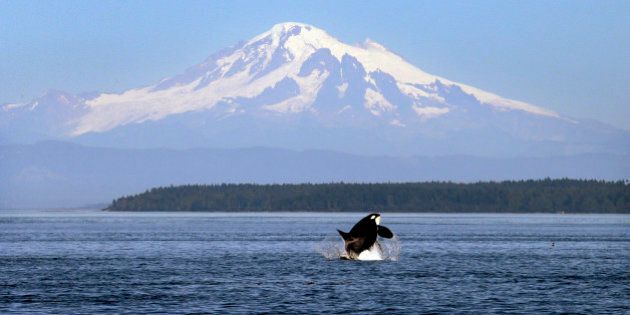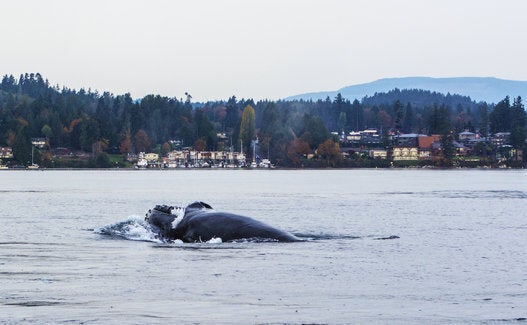
This article was co-authored by Living Oceans Society executive director Karen Wristen, Raincoast Conservation Foundation senior scientist Dr. Paul Paquet and Raincoast executive director Chris Genovali.
Straddling British Columbia and Washington state, the Salish Sea is home to a diverse assemblage of species and habitats. Thousands of streams and rivers drain approximately 7,500 kilometers of coastline into more than 16,000 square kilometers of marine waters. These waters support over a dozen commonly seen marine mammals, 170 bird species, 200 fish species and thousands of species of invertebrates. Weaving through an archipelago containing hundreds of islands, the mixing of large freshwater rivers with marine waters in basins, bays and straits has created an ocean rich with life that is surrounded by outstanding natural beauty.
The Salish Sea is also seen as a desirable place by fossil fuel exporters to ship non-renewable, and typically dangerous, hydrocarbons to foreign markets. One of these proposals is Kinder Morgan's Trans Mountain expansion, which would effectively triple the existing pipeline output from current levels to 890,000 barrels of tar sands oil per day. The consequent escalation in shipping traffic exiting Vancouver's Burrard Inlet would result in more than 400 tankers laden with tar sands oil traveling the Salish Sea every year -- a 500 per cent increase from 2010.
As described in the recently released Raincoast Conservation Foundation report, "Our Threatened Coast: Nature and Benefits in the Salish Sea," the implications of the Kinder Morgan plan are enormous for the Georgia Basin-Puget Sound ecosystem. For example, the proposed tanker route overlays much of the critical habitat of the Salish Sea's endangered southern resident killer whales. Already under pressure from a suite of threats, for these whales to survive it is imperative that risks from shipping and oil spills in the Salish Sea are reduced, not increased.
The Canadian National Energy Board's (NEB) ongoing assessment of the Trans Mountain project has again demonstrated why the tight timelines imposed by the former Conservative federal government's restrictive amendments work to defeat the kind of rigorous scientific assessment that the public is led to expect and undeniably deserves.
In a ruling December 17, 2015, the NEB refused to admit into evidence a formative review by the U.S. National Academy of Sciences commissioned by Congress to assess the potential environmental consequences of spills of tar sands oil, i.e. diluted bitumen (dilbit). In doing so, the NEB claimed that the proponent (Kinder Morgan) would be unduly prejudiced by admitting the evidence late in the hearing process and refused to extend its timelines to incorporate this new and highly relevant information. Notably, however, failure to evaluate existing evidence can result in unnecessary harm. The NEB ruling does not address how denying admission of this new evidence might compromise its own assessment and recommendations.
The National Academy paper, published December 8, 2015, addresses "whether the transport of diluted bitumen in pipelines has potential environmental consequences that are sufficiently different from those of commonly transported crude oils to warrant changes in regulations governing spill response planning, preparedness, and cleanup." The answer is an unequivocal 'yes'. Dilbit is inclined to submerge quite soon after a spill on water and can sink to the bottom even if the oil is less dense than water. Tracking, confining and cleaning up dilbit is an unresolved problem that current technology does not address effectively. Moreover, regulatory processes have failed to come to grips with these concerns.
By contrast, Trans Mountain's application asserts that "Dilbits...[and other Group 3 hydrocarbons] have been transported throughout the world and the general behaviour of these oils are quite comparable with respect to fate and weathering, and spill countermeasures (Vol. 7, p 7-50)." Describing the results of its laboratory analysis, the company claimed that dilbit proved "no different than what might be expected of other conventional heavy crudes when exposed to similar conditions" (Vol. 7, p. 7-56). Importantly, these assertions and claims are largely contradicted by the findings of the far more authoritative National Academy report.
The National Academy report makes seven detailed recommendations to U.S. regulators for changes to spill preparedness and response planning, to address specifically "capabilities for detection, containment, and recovery of submerged and sunken oil". (p.6) The report goes on to observe: "Although many differences between diluted bitumen and commonly transported crudes are well established, there remain areas of uncertainty that hamper effective spill response planning and response to spills. These uncertainties span a range of issues, including diluted bitumen's behaviour in the environment under different conditions, its detection when submerged or sunken, and the best response strategies for mitigating the impacts of submerged and sunken oil."
The National Academy's paper is the most comprehensive and rigorous expert review on these matters that has ever been undertaken, and directly speaks to the key issues that the NEB is mandated to address. The Committee that prepared the paper included Canadian and U.S. experts in a broad range of sciences, as well as in pipeline operations and spill response. Its conclusions and recommendations are at odds with the information presented by Trans Mountain. Specifically, the report emphasizes that there is currently no reliable way to clean up a spill of diluted bitumen, no certainty about the harm that a spill will do or how to mitigate that harm.
The NEB's decision to omit this critically relevant information from consideration exemplifies the flawed review process, as does their basis for refusal: choosing expediency over the rights, needs, and safety of the public. Assessing projects of the magnitude of Trans Mountain, particularly ones that involve novel substances about which little is known, demands time and care.
The timelines imposed on the NEB review have obstructed a thorough, careful examination of the issues. Accordingly, this most recent ruling has resulted in highly relevant evidence being excluded. The NEB remarked that in its role as a regulator of the expanded pipeline, it could consider the National Academy's work later on. By that time, however, Kinder Morgan might already be pumping a supertanker-load of dilbit every day, with no reliable plan or equipment in place that can deal effectively with a spill.
A version of this article previously ran in the Vancouver Sun.
Follow HuffPost Canada Blogs on Facebook
ALSO ON HUFFPOST:
